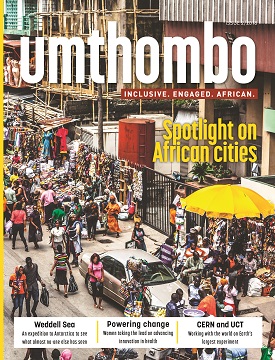With big trees comes great responsibility

University of Cape Town postgraduate researcher, Witness Kozanayi, investigated how commercialisation of baobab products has affected the trees – as well as the communities around them.

African baobabs, such as these in Madagascar, are facing threats ranging from climate change to socio-political factors. UCT researchers looked at the effect of commercialisation on these culturally significant trees and the communities that rely on them.
One of Africa’s most iconic species made global headlines when researchers discovered that some of the oldest and largest baobab trees on the continent had died during the past 12 years. While all signs point to climate change being at least partly to blame for this dying-off, there are socio-political factors that are undoubtedly also affecting the overall well-being of baobabs.
Witness Kozanayi, a student in the Bio-economy Research Chair at the University of Cape Town (UCT) Department of Environmental & Geographical Science, completed a PhD thesis on the governance of non-timber forest products, focused on baobabs.
Conducting his research in the Chimanimani District of eastern Zimbabwe, Kozanayi looked at the way commercialisation of baobab products has had an impact not only on the well-being of the species, but also on the communities making a living from it.
Much more than just a tree
Kozanayi’s study area has one of the highest densities of baobabs in the district – three to 21 trees per hectare. Most of these trees are communally owned and have been managed via customary systems.
Historically, baobabs have served a multitude of purposes for the communities living around them. In addition to providing fruit, bark and leaves, the baobab’s size and shape make these trees perfect vessels for water storage, shelter and burial grounds. In some cases, baobabs have been used for prisons, toilets, ritual sites and venues for prayer.
Over the past few years, however, the allure of the baobab tree has reached far beyond these immediate communities. As demand for novel natural products grows, so does the drive for commercialisation and the need to regulate access.
“Baobab fruit is now recognised as a novel food in the European Union,” explains Kozanayi’s supervisor Professor Rachel Wynberg, South African Research Chair in Bio-Economy at UCT (funded by the South African Department of Science and Technology and the National Research Foundation).
“Governments are increasingly interested in pursuing biodiversity-based economies and in regulating their use, yet this can also lead to negative consequences for resource custodians.”
Benefits of commercialisation
The commercialisation of baobab products holds great promise of entrepreneurship and financial gain for local communities. Most baobab-related industries centre around harvesting and processing the fruit, seeds and bark.
Baobab fruits are sold whole in urban areas or processed into pulp for which confectionery companies are the main market. Oil is extracted from baobab seeds and exported for use in the cosmetics industry, and local residents have been making crafts with the fibrous bark and exporting them to South Africa since the 1990s.
Kozanayi’s research suggests that some households in Nyanyadzi, one of the wards he studied, make between US$350 and US$1 500 per year from involvement with baobab-related projects, with the tree’s products regarded as the most significant contributor to livelihoods in many instances.
The challenges of governance
Despite these promising figures, the relatively sudden commercialisation of baobab products has brought on a crisis of a different sort: implementing effective regulation and governance of this resource.
Throughout their history, communities have relied on strong customary systems to regulate and protect baobabs. However, with the increasing commercialisation of baobab products has come an increasing drive to formalise their management.
“Formalisation of baobab governance is driven mainly by the state to ensure ecological sustainability,” explains Kozanayi.
Shifting the management of baobab resources from traditional leaders to the state has led to disregard for local practices and other negative consequences.
“This is problematic, as evidence on the ground shows that local people do care about the baobab tree which is central to their livelihoods, history and culture,” he says. “Without access to natural resources, local people’s livelihoods are compromised and they are forced to use a range of overt and covert means to regain access.”
The consequences of excessive state regulation include women opting out of the export businesses due to malaitshas – informal cross-border transporters – often demanding sexual favours for facilitating the illegal movement of products. Traders engage malaitshas to circumvent the stringent permit system at the border.
Is there a solution?
As is often the case with commercialisation of age-old resources, the successful governance of baobabs in the Chimanimani District requires a hybrid solution from both the traditional and government sectors. Statutory forms of governance can be introduced to assist customary practices on a demand-driven basis.
Kozanayi argues that due to their proximity to the resource base, traditional leaders are often better placed than the government to be the first line of contact. Simultaneously, the onus is on the state to devote more resources to the management of the baobab tree.
Ultimately, the commercialisation of baobab products can either herald a renewed drive to protect these iconic African trees and the communities whose livelihoods are intertwined with them – or lead to their demise. The outcome will depend on how successfully this precious resource is governed and if compromises can be reached.
Story: Nadia Krige. Photo: Rod Waddington, Flickr.
 |
This story was published in the second issue of Umthombo, a magazine featuring research stories from across the University of Cape Town. Umthombo is the isiXhosa word for a natural spring of water or fountain. The most notable features of a fountain are its natural occurrence and limitlessness. Umthombo as a name positions the University of Cape Town, and this publication in particular, as a non-depletable well of knowledge. Read the complete issue of Umthombo online. |